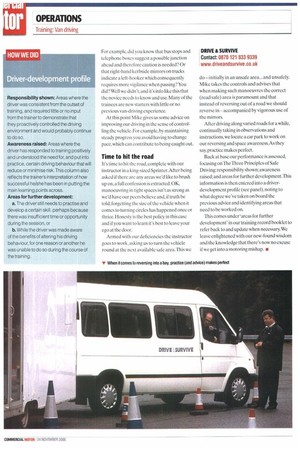DRIVE AND AMBITION
Page 56

Page 57

Page 58

If you've noticed an error in this article please click here to report it so we can fix it.
Training courses might well be of use to novice commercial vehicle drivers, but not for the CM team of experts — or so Julian Miines thought...
If you consider that no formal training is required to drive vans of up to 3.5 tonnes, despite the fact they can reach nearly six metres in length and three metres in height, it's odds-on that someone's going to have an accident at some point.Which is why hundreds of companies each year send thousands of drivers on courses to develop their skills and awarenessAnd, as well as safer roads, what do improved skills lead to? Lower insurance premiums and improved efficiency, of course.
But we at CM like to think our inherently gifted driving abilities need no honing, coming as naturally to us as hunting to a cheetah. Driver training isn't relevant to such advanced motorists —that's what we thought. And of course we were wrong.
Reducing incident frequency
The objective of the catchily named On-road Incident Avoidance Training course is to reduce the frequency of road 'incidents' by creating safer. more aware drivers.Thc training concentrates on developing the driver's mental approach, rather than modifying specific mechanical or control skills.
It's run by Drive & Survive and usually lasts half a day on a one-to-one basis but full-day sessions for two people can also be arranged.
Candidates come from many different industries but Steve Johnson, marketing and communications manager for Drive & Survive,says the majority work in sectors that are already aware of the benefits of managing risk, such as construction and chemicals. -Due to the nature of some businesses there's an inherent culture of risk management and this encourages a proactive nature when looking at driver training," he explains.The course can be adapted to car and truck drivers, but the van training would typically be applicable to couriers or multi-drop drivers.
Johnson adds that not everyone needs to go through hands-on training within a company. "The first step for an organisation is to conduct an online driver assessment through Drive & Survive.This enables us to identify who is at risk, then make our recommendations as to who would need further practical training."
Upon reporting for duty at Prodrive in Warwickshire (trainers can visit a company's premises if required ), we meet our the instructor, an energetic former soldier named Mike, He begins by explaining the day's proceedings. We'l I start off with some practical exercises to gauge our roadcraft (or lack of it),then receive some enlightenment on the steps towards safer driving.After that it'll be time to hit the road and put our new found wisdom into practice.Finally we'll go back to the classroom to run through the positives and negatives and fill out a 'driver-development profile' to plan any future training needs.
No fatalities to report
We open with an informal chat about our driving career so far (no fatalities to report). Then Mike takes us through specific visual scenarios via his laptop, asking questions in the process and identifying potential dangers. We proceed to get half the answers wrong, whether its speed requirements on certain roads, roadsign meanings or simply what to do next given a specific situation. So far, so bad.
He explains that the key to safe driving is reading the road ahead and being aware of your surroundings. By doing this a driver can act in advance before a problem arises. It might sound obvious, but there's more to it. For example, did you know that bus stops and telephone boxes suggest a possible junction ahead and therefore caution is needed? Or that right-hand kerbside mirrors on trucks indicate a left-hooker which consequently requires more vigilance when passing? You did? Well we didn't, and it's info like this that the novice needs to know and use. Many of the trainees are new starters with little or no previous van-driving experience.
At this point Mike gives us some advice on improving our driving in the sense of controlling the vehicle. For example, by maintaining steady progress you avoid having to change pace. which can contribute to being caught out.
Time to hit the road
It's time to hit the road,complete with our instructor in a king-sized Sprinter.After being asked if there are any areas we'd like to brush upon, a full confession is extracted. OK, manoeuvring in tight spaces isn't as strong as we'd have our peers believe and,if truth be told, forgetting the size of the vehicle when it comes to turning circles has happened once or thrice. Honesty is the best policy in this case and if you want to learn it's best to leave your ego at the door.
Armed with our deficiencies the instructor goes to work, asking us to turn the vehicle round at the next available safe area.This we do-initially in an unsafe area... and unsafely. Mike takes the controls and advises that when making such manoeuvres the correct (read safe) area is paramount and that instead of reversing out of a road we should reverse in accompanied by vigorous use of the mirrors.
After driving along varied roads for a while, continually taking in observations and instructions, we locate a car park to work on our reversing and space awareness. As they say. practice makes perfect.
Back at base our performance is assessed, focusing onThe Three Principles of Safe Driving: responsibility shown; awareness raised; and areas for further development.This information is then entered into a driverdevelopment profile (see panel), noting to what degree we've taken on board the previous advice and identifying areas that need to be worked on.
This comes underareas for further development' in our training record booklet to refer back to and update when necessary. We leave enlightened with our new-found wisdom and the knowledge that there's now no excuse if we get into a motoring mishap. •






































































































































































































